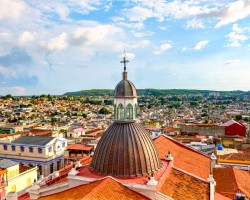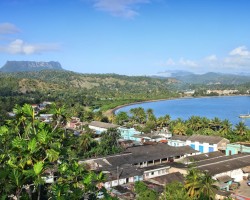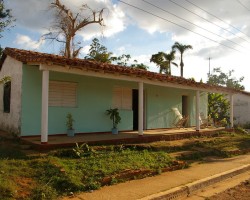Best time to go to Cuba for a perfect weather and where to go?
When is the best time to go to Cuba?
Cuba is ideal for tourist visits all year round. You can choose the time that suits you best to combine cultural discoveries with relaxing stays. However, if you're wondering when to go to Cuba to enjoy the nice weather, you should favor the dry season which runs from November to April. This is the best time to visit Cuba. You will find pleasant temperatures and sunny weather. This season also corresponds to the high tourist season. Indeed, in Europe and America, the weather is not great, so travelers take advantage to head to sunny destinations. Your travel budget may therefore be higher compared to other times. Moreover, from April to November, Cuba experiences the wet season, but the weather remains pleasant enough for tourists to enjoy their stay. Traveling to Cuba during the rainy season also means being able to enjoy the beaches, stroll through the streets of colonial cities, and take a ride in a vintage car as one dreams of! Furthermore, by organizing your trip during this period, you can also enjoy local festivities, especially the Santiago de Cuba carnival, which takes place in July. During the wet season, showers are frequent indeed, but they pass quickly. The sun is often shining. Finally, the only period to avoid for a trip to Cuba is during hurricane season, between August and October. They regularly hit the coasts of Cuba bringing torrential rains and strong winds. Although the weather is generally fine during this period, travelers often prefer to err on the side of caution.
Where and when to go based on the weather?
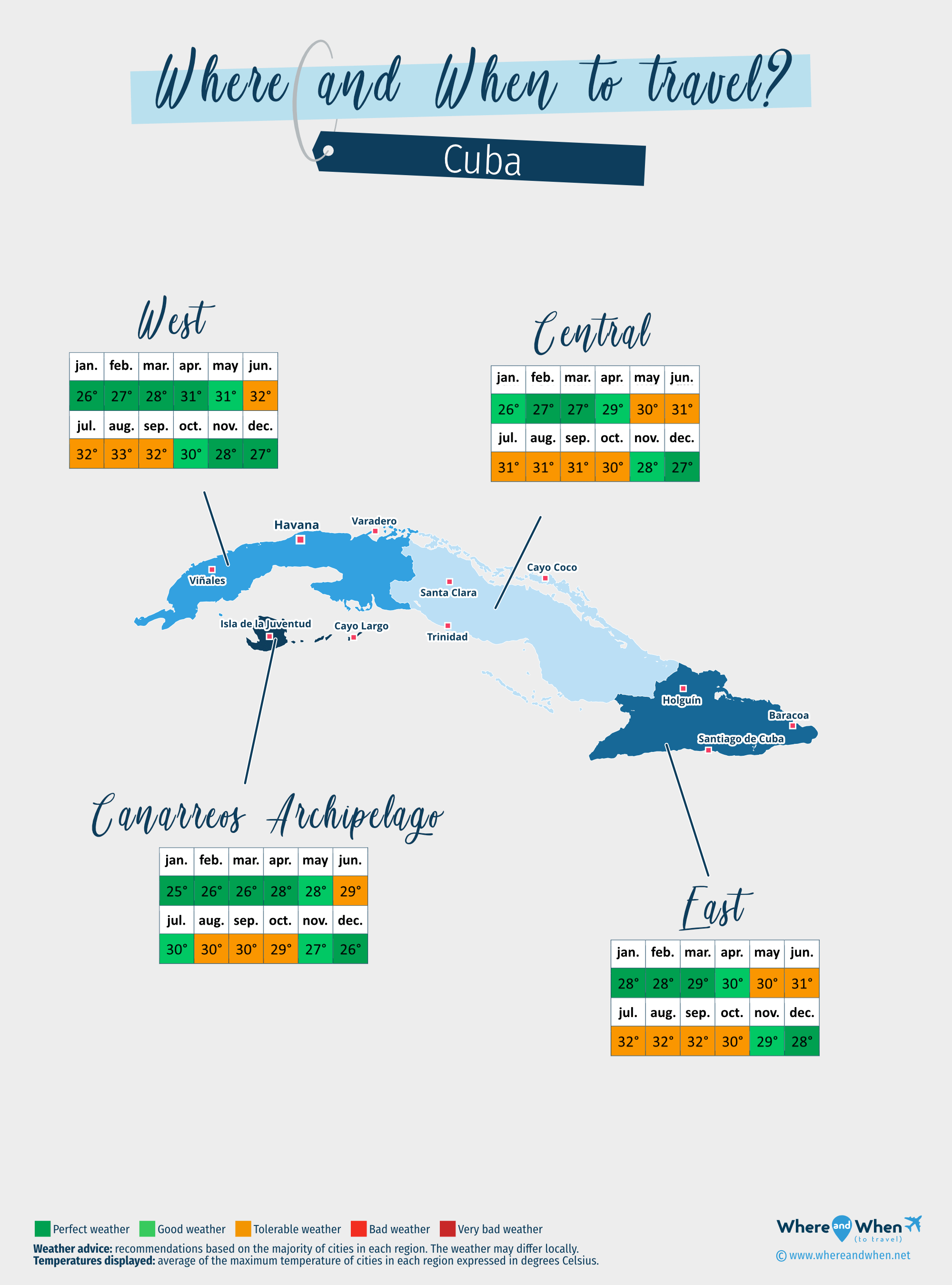
Canarreos Archipelago
Cayo Largo, Isla de la Juventud, Cayo Cantiles...
Central of Cuba
Cayo Coco, Trinidad, Santa Clara...
East of Cuba
Holguín, Santiago de Cuba, Baracoa...
West of Cuba
Havana, Varadero, Vinales...
To get all the information about the climate and weather in Cuba for a specific month, click on the corresponding link below:
Cuba in january Cuba in february Cuba in march Cuba in april Cuba in may Cuba in june Cuba in july Cuba in august Cuba in september Cuba in october Cuba in november Cuba in december
Best time to travel to Cuba by cities
Climate and Weather in Cuba
Located off the coast of the United States, a few kilometers from the Bahamas and the Dominican Republic, the island of Cuba has a moderate subtropical climate with a predominance of hot temperatures. Indeed, due to its location at the entrance of the Gulf of Mexico, Cuba's climate is particularly mild. There are around 330 sunny days per year! While the sea temperature is pleasant throughout the island, it is even warmer in the south, especially towards Santiago de Cuba, where it easily rises by 2 to 3°C (38°F) .
On-site, two seasons alternate:
- the dry season from November to April
- the rainy season from April to November
The rainy season
This season is characterized by sudden rains that do not last long. They occur in the form of heavy showers and often fall late in the day. The rainiest months are August and September with nearly 260mm of precipitation depending on the regions.
Furthermore, the rainy season in Cuba is particularly hot. Temperatures range from 25 to 35°C (95°F) . The atmosphere is also very humid, making the heat stifling at times.
Cuba is also a region regularly affected by hurricanes. Indeed, the hurricane season extends from June to November on the island. However, these events are more frequent between the months of August to October. Hurricanes, like Irma in 2017, generally cause deaths and significant material damage.
Climate in Cuba - The dry season
The dry season in Cuba is characterized by sunny weather and pleasant temperatures without being too hot. Temperatures are generally between 20 and 30°C (86°F) .
During winter, cold winds blow through the north of the island, which can give the impression that the weather is too cool for the beach. However, you can always opt for the southeast region, which has a warmer climate as it is less exposed to the winds. Generally, it is especially at night that temperatures drop, allowing travelers to fully enjoy their vacations.
However, as in any tropical region, short showers can occur regularly even during this season. They usually pass in less than an hour.
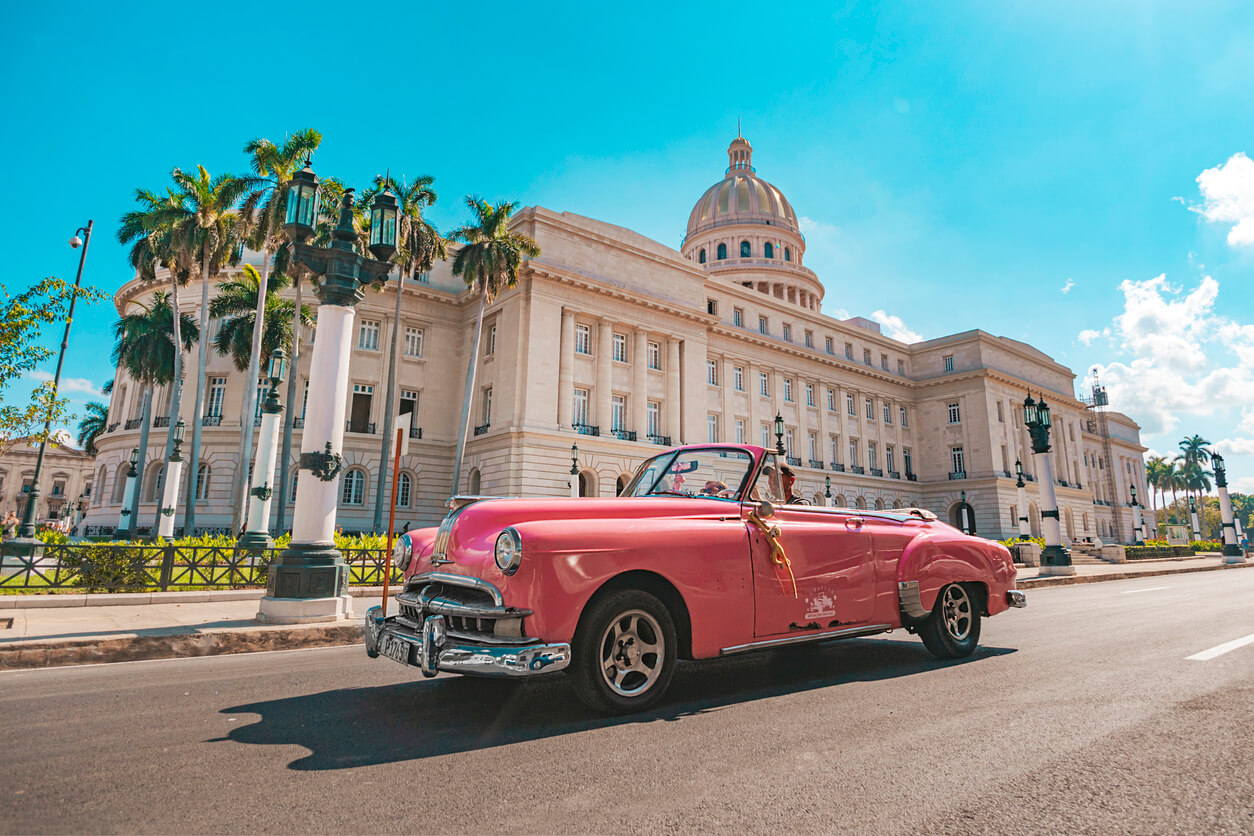
Cuba is not a particularly large island and it has few relief features. However, the weather in Cuba is slightly different depending on the regions.
Climate in Cuba - Northwest of the island
The northern part of Cuba is exposed to cold air from the United States during the winter. As a result, temperatures are generally cooler there than in the south of the island. In the region of Havana and Varadero, however, there is clear skies during the dry season with a significant decrease in precipitation.
While the months from December to March are the driest in the capital, the weather is favorable from October to May. However, during the wet season, precipitation does not exceed 150 mm per month. It often rains, but in the form of short showers. However, the sky can be quite cloudy at times.
On the tourist islands of Cayo Coco or Cayo Guillermo, the weather is almost perfect all year round. Indeed, temperatures range from 25 to 32°C (90°F) and the weather is mostly sunny. The only month to avoid is September as it is the rainiest.
Climate in Cuba - Southeast of the island
This region has a consistently ideal climate throughout the year. There are fewer precipitations than in the west and warmer temperatures. The cities of Baracoa and Santiago de Cuba are ideal for a trip all year round.
Moreover, in this region, the difference between the rainy season and the dry season is less pronounced as it rains between 10 and 15 days per month all year round. However, here too, precipitation comes in the form of passing showers that occur in the late afternoon or at night. Nothing that will really disrupt your stay…
On the other hand, the humidity level in this region is often above 80%, leading to a humid atmosphere and a feeling of stifling heat. Fortunately, the sea is never far in Cuba…
Indeed, the sea temperature ranges from 26 to 30°C (86°F) all year round in Santiago de Cuba. This region will therefore be ideal for relaxing on the island's beaches.
Temperatures and rainfall in Cuba
On these 3 graphs, we present the evolution of temperatures of Cuba and month-by-month rainfall for the cities of Havana, Cayo Coco, Holguín, Santa Clara and Santiago de Cuba, as well as the month-by-month sea temperature for coastal cities.

Peak visitor numbers and tourist seasons in Cuba
Find out when Cuba has its high tourist season (the period when the influx of tourists is highest) and off-peak tourist season using our data and figures.
Tourist seasons in Cuba
The months with low numbers of tourists are: May, June, July, September and October. The number of visitors to Cuba is high in: January, February, March, April, August, November and December.
- Very low season in Cuba: May, June and September.
- Low season in Cuba: July and October.
- High season in Cuba: March and April.
- Peak season in Cuba: January, February, August, November and December.
Figure: Visitor index for Cuba month by month
Average price for flights to Cuba
A return flight between London and Havana is generally cheaper if you go in june ($ 837 on average): this is the best time for travellers on a tight budget. In contrast, you may end up paying $ 464 more for your airline ticket to Havana if you go in august.
Where to go in Cuba?
This table allows you to see the maximum temperature for each city and our opinion on the weather month by month (see colour legend below the table).
| Cities | jan. | feb. | mar. | apr. | may | jun. | jul. | aug. | sep. | oct. | nov. | dec. |
| Havana | 79°F | 83°F | 85°F | 90°F | 90°F | 90°F | 92°F | 92°F | 92°F | 88°F | 83°F | 81°F |
| Cayo Coco | 77°F | 77°F | 77°F | 81°F | 83°F | 85°F | 86°F | 86°F | 86°F | 85°F | 81°F | 79°F |
| Holguín | 85°F | 86°F | 86°F | 90°F | 90°F | 92°F | 94°F | 94°F | 92°F | 90°F | 86°F | 85°F |
| Santa Clara | 81°F | 83°F | 85°F | 90°F | 90°F | 90°F | 92°F | 92°F | 90°F | 88°F | 83°F | 83°F |
| Santiago de Cuba | 85°F | 86°F | 86°F | 88°F | 88°F | 90°F | 92°F | 92°F | 90°F | 90°F | 88°F | 86°F |
| Trinidad | 79°F | 81°F | 83°F | 85°F | 85°F | 86°F | 88°F | 88°F | 86°F | 85°F | 83°F | 81°F |
| Varadero | 79°F | 83°F | 83°F | 88°F | 88°F | 90°F | 92°F | 92°F | 90°F | 86°F | 83°F | 81°F |
| Baracoa | 81°F | 81°F | 81°F | 83°F | 85°F | 86°F | 86°F | 86°F | 86°F | 86°F | 83°F | 81°F |
| Camagüey | 83°F | 86°F | 86°F | 90°F | 90°F | 92°F | 92°F | 94°F | 92°F | 88°F | 85°F | 85°F |
| Cayo Largo | 79°F | 79°F | 79°F | 81°F | 83°F | 85°F | 86°F | 86°F | 86°F | 85°F | 83°F | 81°F |
| Isla de la Juventud | 79°F | 79°F | 81°F | 85°F | 85°F | 86°F | 88°F | 88°F | 88°F | 86°F | 83°F | 81°F |
| Vinales | 79°F | 81°F | 85°F | 88°F | 88°F | 90°F | 92°F | 92°F | 90°F | 86°F | 83°F | 81°F |
| Bayamo | 85°F | 86°F | 88°F | 90°F | 90°F | 92°F | 94°F | 94°F | 92°F | 90°F | 86°F | 85°F |
| Caibarién (La Villa Blanca) | 79°F | 81°F | 81°F | 85°F | 86°F | 88°F | 88°F | 90°F | 88°F | 86°F | 83°F | 81°F |
| Cárdenas | 79°F | 83°F | 83°F | 88°F | 88°F | 90°F | 92°F | 92°F | 90°F | 86°F | 83°F | 81°F |
| Cayo Cruz | 77°F | 77°F | 77°F | 81°F | 83°F | 85°F | 86°F | 86°F | 86°F | 85°F | 81°F | 79°F |
| Cayo Guillermo | 77°F | 77°F | 77°F | 81°F | 83°F | 85°F | 86°F | 86°F | 86°F | 85°F | 81°F | 79°F |
| Cayo Levisa | 79°F | 83°F | 85°F | 88°F | 90°F | 90°F | 92°F | 92°F | 90°F | 88°F | 83°F | 81°F |
| Cayo Romano | 77°F | 77°F | 77°F | 81°F | 83°F | 85°F | 86°F | 86°F | 86°F | 85°F | 81°F | 79°F |
| Cayo Sabinal | 81°F | 83°F | 83°F | 86°F | 88°F | 90°F | 90°F | 92°F | 90°F | 88°F | 85°F | 83°F |
Legend:
perfect weather
good weather
tolerable weather
bad weather
About Cuba
What can I do in Cuba?
Beaches / swimming
Nature and countryside
Culture and heritage
Sports
Family travel
Crafts / shopping
Gastronomy
Nightlife
Is this weather information for Cuba reliable?
Climate data for Cuba has been gathered every day since January 2009. The analysis of these meteorological data for Cuba allows us to determine the average for each month in Havana, Cayo Coco, Holguín, Santa Clara, Santiago de Cuba, Trinidad, Varadero, Baracoa, and 57 other cities.
So yes: this data is reliable except in cases of temporary climate disruption in the region.





